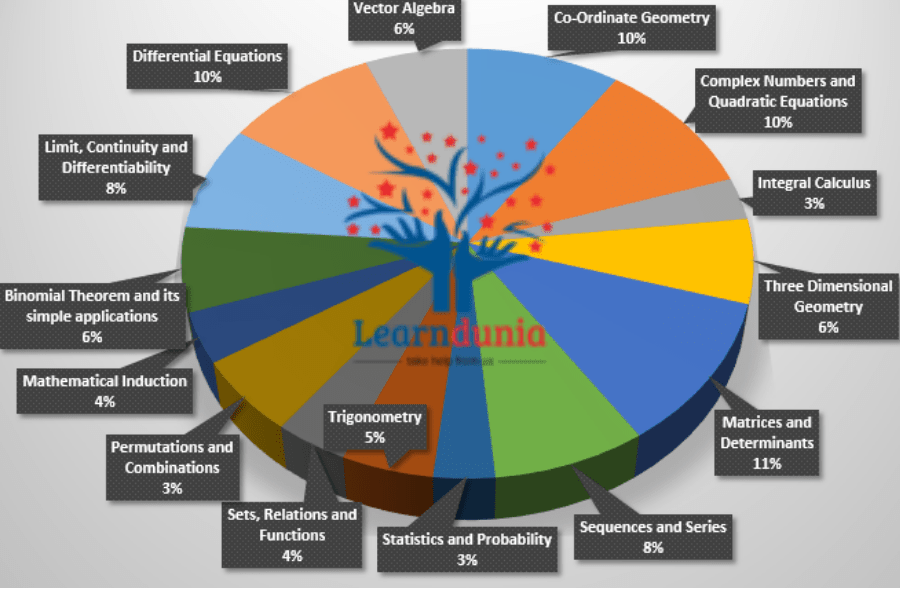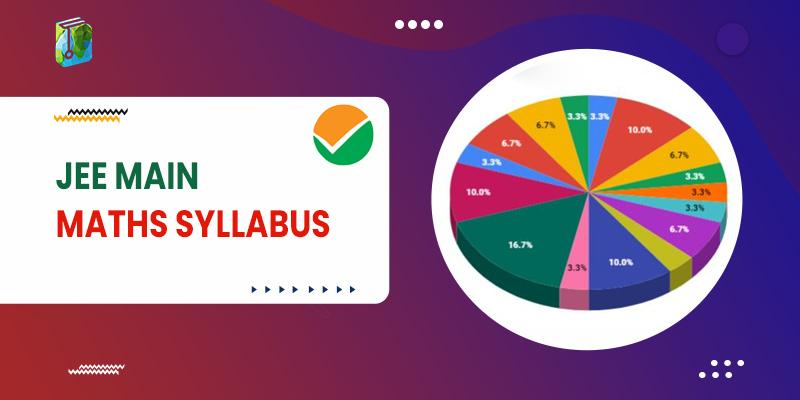The National Testing Agency (NTA) has released the Mathematics syllabus for JEE Main 2024. This syllabus is essential for students preparing for the upcoming examination.
NTA oversees various aspects of the JEE Main examination, including releasing admit cards, result announcements, and more. Despite changes in other areas, the syllabus for Mathematics mostly remains unchanged. Familiarizing oneself with the JEE Main Maths syllabus will enable students to devise an effective study strategy for IIT JEE 2024 in an organized manner.
JEE Main Maths Syllabus 2024
The complete JEE Main Syllabus 2024 for Mathematics is given below:
UNIT 1: Sets, Relations, and Functions
| Sets, Relations, and Functions |
Sets and their representation; Union, intersection and complement of sets and their algebraic properties; Power set; Relation, Types of relations, equivalence relations, functions; one-one, into and onto functions, the composition of functions. |
UNIT 2: Complex Numbers and Quadratic Equations
| Complex Numbers and Quadratic Equations |
Complex numbers as ordered pairs of reals, Representation of complex numbers in the form a+ib and their representation in a plane, Argand diagram, algebra of complex numbers, modulus and argument (or amplitude) of a complex number, square root of a complex number, triangle inequality, Quadratic equations in real and complex number system and their solutions. The relation between roots and coefficients, nature of roots, the formation of quadratic equations with given roots. |
UNIT 3: Matrices and Determinants
| Matrices and Determinants |
Matrices, algebra of matrices, types of matrices, determinants, and matrices of order two and three. Properties of determinants, evaluation of determinants, area of triangles using determinants. Adjoint and evaluation of inverse of a square matrix using determinants and elementary transformations, Test of consistency and solution of simultaneous linear equations in two or three variables using determinants and matrices. |
UNIT 4: Permutations and Combinations
| Permutations and Combinations |
The fundamental principle of counting, permutation as an arrangement and combination as selection, Meaning of P (n,r) and C (n,r), simple applications. |
UNIT 5: Mathematical Induction
| Mathematical Induction |
Principle of Mathematical Induction and its simple applications. |
UNIT 6: Binomial Theorem
| Binomial Theorem |
Binomial theorem for a positive integral index, general term and middle term, properties of Binomial coefficients, and simple applications. |
UNIT 7: Sequences and Series
| Sequences and Series |
Arithmetic and Geometric progressions, insertion of arithmetic, geometric means between two given numbers. The relation between A.M. and G.M. Sum up to n terms of special series: Sn, Sn2, Sn3. Arithmetic – Geometric progression. |
UNIT 8: Limit, Continuity, and Differentiability
| Limit, Continuity, and Differentiability |
Real-valued functions, algebra of functions, polynomials, rational, trigonometric, logarithmic, and exponential functions, inverse functions. Graphs of simple functions. Limits, continuity, and differentiability. Differentiate the sum, difference, product, and quotient of two functions. Differentiation of trigonometric, inverse trigonometric, logarithmic, exponential, composite, and implicit functions; derivatives of order up to two. Rolle’s and Lagrange’s Mean Value Theorems. Applications of derivatives: Rate of change of quantities, monotonic – increasing and decreasing functions, Maxima and minima of functions of one variable, tangents, and normals. |
UNIT 9: Integral Calculus
| Integral Calculus |
Integral as an antiderivative. Fundamental integrals involving algebraic, trigonometric, exponential, and logarithmic functions. Integration by substitution, by parts, and by partial fractions. Integration using trigonometric identities.
Integral as limit of a sum. Fundamental Theorem of Calculus. Properties of definite integrals. Evaluation of definite integrals, determining areas of the regions bounded by simple curves in standard form. |
UNIT 10: Differential Equations
| Differential Equations |
Ordinary differential equations, their order, and degree. Formation of differential equations. The solution of differential equations by separating variables, solution of homogeneous and linear differential equations of the type. |
UNIT 11: Coordinate Geometry
|
Coordinate Geometry
Cartesian system of rectangular coordinates in a plane, distance formula, section formula, locus, and its equation, translation of axes, the slope of a line, parallel and perpendicular lines, and intercepts of a line on the coordinate axes. |
| Straight lines |
Various forms of equations of a line, intersection of lines, angles between two lines, conditions for concurrence of three lines, the distance of a point from a line, equations of internal and external bisectors of angles between two lines, coordinates of centroid, orthocentre, and circumcentre of a triangle, equation of the family of lines passing through the point of intersection of two lines. |
| Circles, conic sections
|
The standard form of the equation of a circle, the general form of the equation of a circle, its radius and center, equation of a circle when the endpoints of a diameter are given, points of intersection of a line, and a circle with the center at the origin and condition for a line to be tangent to a circle, equation of the tangent. Sections of cones, equations of conic sections (parabola, ellipse, and hyperbola) in standard forms, condition for y = MX + c to be a tangent and point (s) of tangency. |
UNIT 12: Three Dimensional Geometry
| Three Dimensional Geometry |
Coordinates of a point in space, the distance between two points, section formula, direction ratios, and direction cosines, the angle between two intersecting lines. Skew lines, the shortest distance between them, and their equation. Equations of a line and a plane in different forms, the intersection of a line and a plane, coplanar lines. |
UNIT 13: Vector Algebra
| Vector Algebra |
Vectors and scalars, the addition of vectors, components of a vector in two dimensions and three-dimensional space, scalar and vector products, scalar and vector triple product. |
UNIT 14: Statistics and Probability
Statistics and Probability
|
| Measures of Dispersion |
Calculation of mean, median, mode of grouped and ungrouped data. Calculation of standard deviation, variance, and mean deviation for grouped and ungrouped data. |
| Probability
|
Probability of an event, addition and multiplication theorems of probability, Bayes theorem, the probability distribution of a random variate, Bernoulli trials, and Binomial distribution. |
UNIT 15: Trigonometry
Trigonometry
|
Trigonometric identities and equations. Trigonometric functions. Inverse trigonometric functions and their properties. Heights and Distances. |
UNIT 16: Mathematical Reasoning
| Mathematical Reasoning |
Statements, logical operations, and, or, implies, implied by, if and only if—understanding of tautology, contradiction, converse, and contrapositive. |
Best JEE Main Maths Books
JEE Main Maths Syllabus Weightage

Conclusion
Every year lakhs of candidates prepare for the JEE Main examination to get admission to the reputed institutions.
Mathematics is a scoring subject; students must prepare efficiently to gain good marks. Prepare effectively to escalate your final score and crack this prestigious examination.
Good luck with all your future endeavors!
People are also reading:


